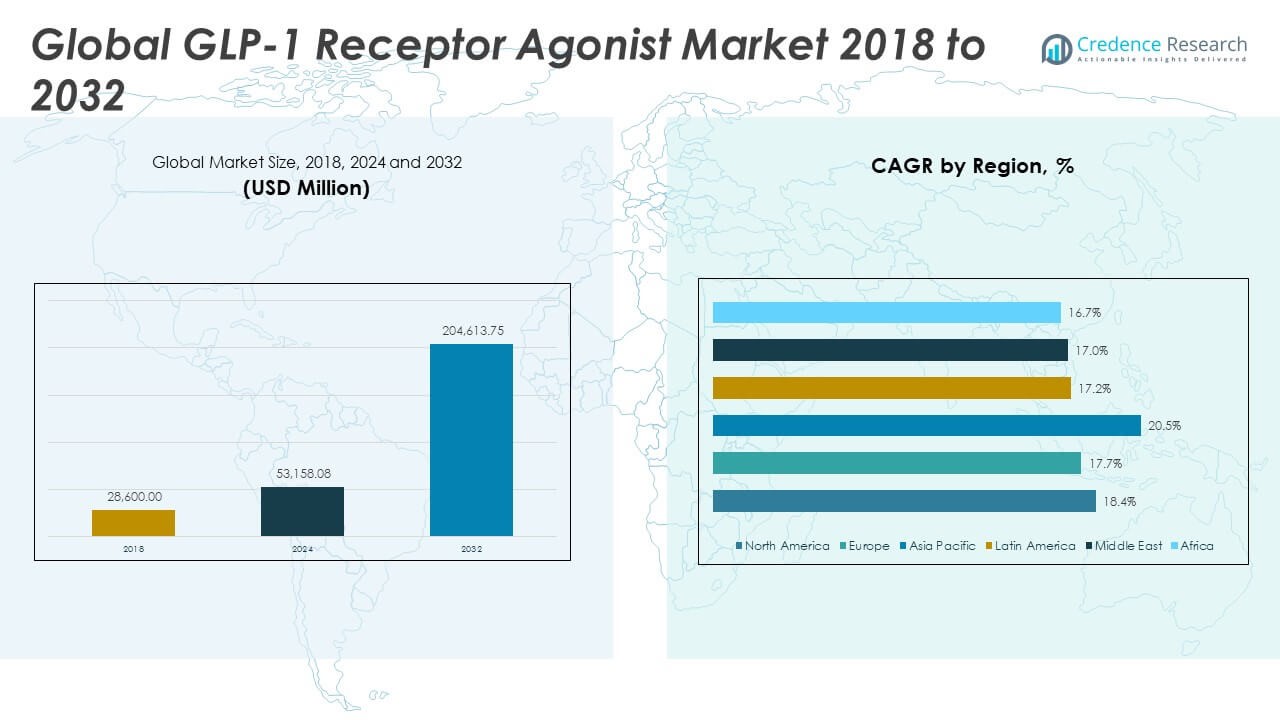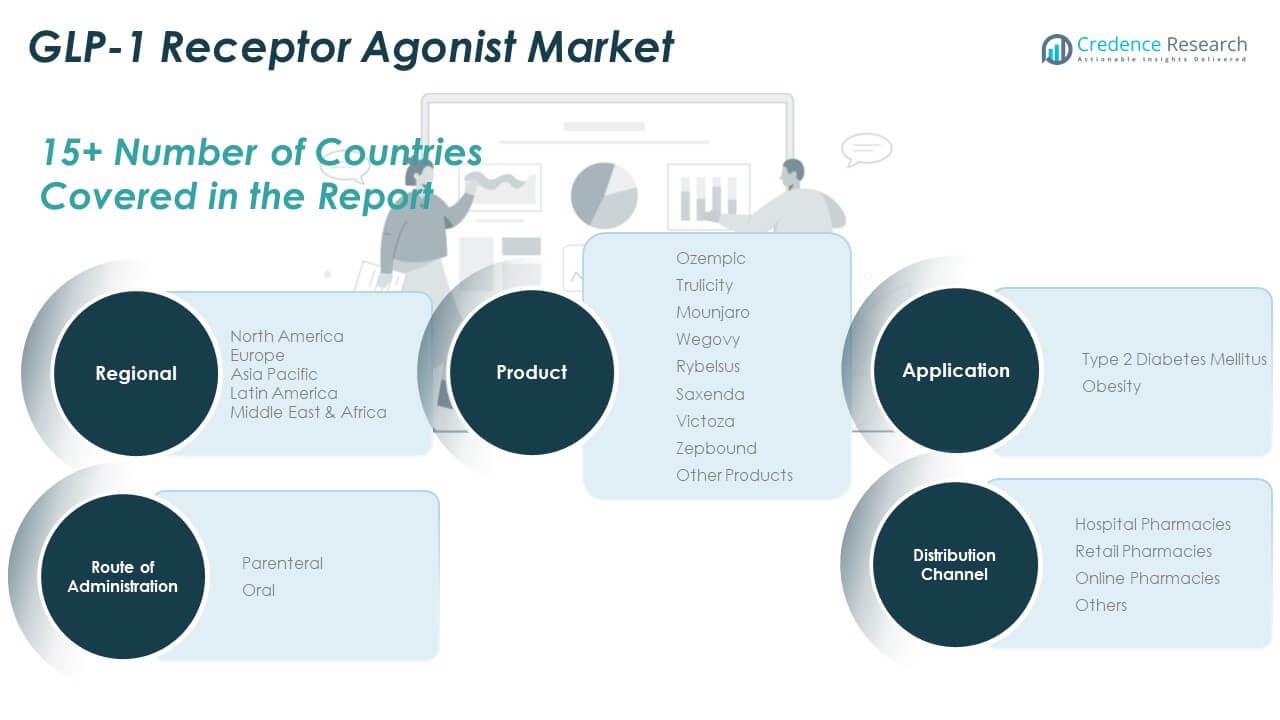CHAPTER NO. 1 : GENESIS OF THE MARKET
1.1 Market Prelude – Introduction & Scope
1.2 The Big Picture – Objectives & Vision
1.3 Strategic Edge – Unique Value Proposition
1.4 Stakeholder Compass – Key Beneficiaries
CHAPTER NO. 2 : EXECUTIVE LENS
2.1 Pulse of the Industry – Market Snapshot
2.2 Growth Arc – Revenue Projections (USD Million)
2.3. Premium Insights – Based on Primary Interviews
CHAPTER NO. 3 : GLP-1 RECEPTOR AGONIST MARKET FORCES & INDUSTRY PULSE
3.1 Foundations of Change – Market Overview
3.2 Catalysts of Expansion – Key Market Drivers
3.2.1 Momentum Boosters – Growth Triggers
3.2.2 Innovation Fuel – Disruptive Technologies
3.3 Headwinds & Crosswinds – Market Restraints
3.3.1 Regulatory Tides – Compliance Challenges
3.3.2 Economic Frictions – Inflationary Pressures
3.4 Untapped Horizons – Growth Potential & Opportunities
3.5 Strategic Navigation – Industry Frameworks
3.5.1 Market Equilibrium – Porter’s Five Forces
3.5.2 Ecosystem Dynamics – Value Chain Analysis
3.5.3 Macro Forces – PESTEL Breakdown
3.6 Price Trend Analysis
3.6.1 Regional Price Trend
3.6.2 Price Trend by product
CHAPTER NO. 4 : KEY INVESTMENT EPICENTER
4.1 Regional Goldmines – High-Growth Geographies
4.2 Product Frontiers – Lucrative Product Categories
4.3 Application Sweet Spots – Emerging Demand Segments
CHAPTER NO. 5: REVENUE TRAJECTORY & WEALTH MAPPING
5.1 Momentum Metrics – Forecast & Growth Curves
5.2 Regional Revenue Footprint – Market Share Insights
5.3 Segmental Wealth Flow – Product & Application Revenue
CHAPTER NO. 6 : TRADE & COMMERCE ANALYSIS
6.1. Import Analysis by Region
6.1.1. Global GLP-1 Receptor Agonist Market Import Revenue By Region
6.2. Export Analysis by Region
6.2.1. Global GLP-1 Receptor Agonist Market Export Revenue By Region
CHAPTER NO. 7 : COMPETITION ANALYSIS
7.1. Company Market Share Analysis
7.1.1. Global GLP-1 Receptor Agonist Market: Company Market Share
7.2. Global GLP-1 Receptor Agonist Market Company Revenue Market Share
7.3. Strategic Developments
7.3.1. Acquisitions & Mergers
7.3.2. New Product Launch
7.3.3. Regional Expansion
7.4. Competitive Dashboard
7.5. Company Assessment Metrics, 2024
CHAPTER NO. 8 : GLP-1 RECEPTOR AGONIST MARKET – BY PRODUCT SEGMENT ANALYSIS
8.1. GLP-1 Receptor Agonist Market Overview by Product Segment
8.1.1. GLP-1 Receptor Agonist Market Revenue Share By Product
8.2. Ozempic
8.3. Trulicity
8.4. Mounjaro
8.5. Wegovy
8.6. Rybelsus
8.7. Saxenda
8.8. Victoza
8.9. Zepbound
8.10. Other Products
CHAPTER NO. 9 : GLP-1 RECEPTOR AGONIST MARKET – BY APPLICATION SEGMENT ANALYSIS
9.1. GLP-1 Receptor Agonist Market Overview by Application Segment
9.1.1. GLP-1 Receptor Agonist Market Revenue Share By Application
9.2. Type 2 Diabetes Mellitus
9.3. Obesity
CHAPTER NO. 10 : GLP-1 RECEPTOR AGONIST MARKET – BY ROUTE OF ADMINISTRATION SEGMENT ANALYSIS
10.1. GLP-1 Receptor Agonist Market Overview by Route of Administration Segment
10.1.1. GLP-1 Receptor Agonist Market Revenue Share By Route of Administration
10.2. Parenteral
10.3. Oral
CHAPTER NO. 11 : GLP-1 RECEPTOR AGONIST MARKET – BY DISTRIBUTION CHANNEL SEGMENT ANALYSIS
11.1. GLP-1 Receptor Agonist Market Overview by Distribution Channel Segment
11.1.1. GLP-1 Receptor Agonist Market Revenue Share By Distribution Channel
11.2. Hospital Pharmacies
11.3. Retail Pharmacies
11.4. Online Pharmacies
11.5. Others
CHAPTER NO. 12 : GLP-1 RECEPTOR AGONIST MARKET – REGIONAL ANALYSIS
12.1. GLP-1 Receptor Agonist Market Overview by Region Segment
12.1.1. Global GLP-1 Receptor Agonist Market Revenue Share By Region
12.1.2. Regions
12.1.3. Global GLP-1 Receptor Agonist Market Revenue By Region
12.1.4. Product
12.1.5. Global GLP-1 Receptor Agonist Market Revenue By Product
12.1.6. Application
12.1.7. Global GLP-1 Receptor Agonist Market Revenue By Application
12.1.8. Route of Administration
12.1.9. Global GLP-1 Receptor Agonist Market Revenue By Route of Administration
12.1.10. Distribution Channel
12.1.11. Global GLP-1 Receptor Agonist Market Revenue By Distribution Channel
CHAPTER NO. 13 : NORTH AMERICA GLP-1 RECEPTOR AGONIST MARKET – COUNTRY ANALYSIS
13.1. North America GLP-1 Receptor Agonist Market Overview by Country Segment
13.1.1. North America GLP-1 Receptor Agonist Market Revenue Share By Region
13.2. North America
13.2.1. North America GLP-1 Receptor Agonist Market Revenue By Country
13.2.2. Product
13.2.3. North America GLP-1 Receptor Agonist Market Revenue By Product
13.2.4. Application
13.2.5. North America GLP-1 Receptor Agonist Market Revenue By Application
13.2.6. Route of Administration
13.2.7. North America GLP-1 Receptor Agonist Market Revenue By Route of Administration
13.2.8. Distribution Channel
13.2.9. North America GLP-1 Receptor Agonist Market Revenue By Distribution Channel
13.3. U.S.
13.4. Canada
13.5. Mexico
CHAPTER NO. 14 : EUROPE GLP-1 RECEPTOR AGONIST MARKET – COUNTRY ANALYSIS
14.1. Europe GLP-1 Receptor Agonist Market Overview by Country Segment
14.1.1. Europe GLP-1 Receptor Agonist Market Revenue Share By Region
14.2. Europe
14.2.1. Europe GLP-1 Receptor Agonist Market Revenue By Country
14.2.2. Product
14.2.3. Europe GLP-1 Receptor Agonist Market Revenue By Product
14.2.4. Application
14.2.5. Europe GLP-1 Receptor Agonist Market Revenue By Application
14.2.6. Route of Administration
14.2.7. Europe GLP-1 Receptor Agonist Market Revenue By Route of Administration
14.2.8. Distribution Channel
14.2.9. Europe GLP-1 Receptor Agonist Market Revenue By Distribution Channel
14.3. UK
14.4. France
14.5. Germany
14.6. Italy
14.7. Spain
14.8. Russia
14.9. Rest of Europe
CHAPTER NO. 15 : ASIA PACIFIC GLP-1 RECEPTOR AGONIST MARKET – COUNTRY ANALYSIS
15.1. Asia Pacific GLP-1 Receptor Agonist Market Overview by Country Segment
15.1.1. Asia Pacific GLP-1 Receptor Agonist Market Revenue Share By Region
15.2. Asia Pacific
15.2.1. Asia Pacific GLP-1 Receptor Agonist Market Revenue By Country
15.2.2. Product
15.2.3. Asia Pacific GLP-1 Receptor Agonist Market Revenue By Product
15.2.4. Application
15.2.5. Asia Pacific GLP-1 Receptor Agonist Market Revenue By Application
15.2.6. Route of Administration
15.2.7. Asia Pacific GLP-1 Receptor Agonist Market Revenue By Route of Administration
15.2.8. Distribution Channel
15.2.9. Asia Pacific GLP-1 Receptor Agonist Market Revenue By Distribution Channel
15.3. China
15.4. Japan
15.5. South Korea
15.6. India
15.7. Australia
15.8. Southeast Asia
15.9. Rest of Asia Pacific
CHAPTER NO. 16 : LATIN AMERICA GLP-1 RECEPTOR AGONIST MARKET – COUNTRY ANALYSIS
16.1. Latin America GLP-1 Receptor Agonist Market Overview by Country Segment
16.1.1. Latin America GLP-1 Receptor Agonist Market Revenue Share By Region
16.2. Latin America
16.2.1. Latin America GLP-1 Receptor Agonist Market Revenue By Country
16.2.2. Product
16.2.3. Latin America GLP-1 Receptor Agonist Market Revenue By Product
16.2.4. Application
16.2.5. Latin America GLP-1 Receptor Agonist Market Revenue By Application
16.2.6. Route of Administration
16.2.7. Latin America GLP-1 Receptor Agonist Market Revenue By Route of Administration
16.2.8. Distribution Channel
16.2.9. Latin America GLP-1 Receptor Agonist Market Revenue By Distribution Channel
16.3. Brazil
16.4. Argentina
16.5. Rest of Latin America
CHAPTER NO. 17 : MIDDLE EAST GLP-1 RECEPTOR AGONIST MARKET – COUNTRY ANALYSIS
17.1. Middle East GLP-1 Receptor Agonist Market Overview by Country Segment
17.1.1. Middle East GLP-1 Receptor Agonist Market Revenue Share By Region
17.2. Middle East
17.2.1. Middle East GLP-1 Receptor Agonist Market Revenue By Country
17.2.2. Product
17.2.3. Middle East GLP-1 Receptor Agonist Market Revenue By Product
17.2.4. Application
17.2.5. Middle East GLP-1 Receptor Agonist Market Revenue By Application
17.2.6. Route of Administration
17.2.7. Middle East GLP-1 Receptor Agonist Market Revenue By Route of Administration
17.2.8. Distribution Channel
17.2.9. Middle East GLP-1 Receptor Agonist Market Revenue By Distribution Channel
17.3. GCC Countries
17.4. Israel
17.5. Turkey
17.6. Rest of Middle East
CHAPTER NO. 18 : AFRICA GLP-1 RECEPTOR AGONIST MARKET – COUNTRY ANALYSIS
18.1. Africa GLP-1 Receptor Agonist Market Overview by Country Segment
18.1.1. Africa GLP-1 Receptor Agonist Market Revenue Share By Region
18.2. Africa
18.2.1. Africa GLP-1 Receptor Agonist Market Revenue By Country
18.2.2. Product
18.2.3. Africa GLP-1 Receptor Agonist Market Revenue By Product
18.2.4. Application
18.2.5. Africa GLP-1 Receptor Agonist Market Revenue By Application
18.2.6. Route of Administration
18.2.7. Africa GLP-1 Receptor Agonist Market Revenue By Route of Administration
18.2.8. Distribution Channel
18.2.9. Africa GLP-1 Receptor Agonist Market Revenue By Distribution Channel
18.3. South Africa
18.4. Egypt
18.5. Rest of Africa
CHAPTER NO. 19 : COMPANY PROFILES
19.1. Eli Lilly and Company
19.1.1. Company Overview
19.1.2. Product Portfolio
19.1.3. Financial Overview
19.1.4. Recent Developments
19.1.5. Growth Strategy
19.1.6. SWOT Analysis
19.2. Sanofi
19.3. Novo-Nordisk A/S
19.4. AstraZeneca
19.5. Pfizer.Inc
19.6. Amgen, Inc.
19.7. Innovent Biologics, Inc.
19.8. PegBio Co., Ltd.
19.9. Sun Pharmaceutical Industries Ltd.
19.10. Boehringer Ingelheim International GmbH





